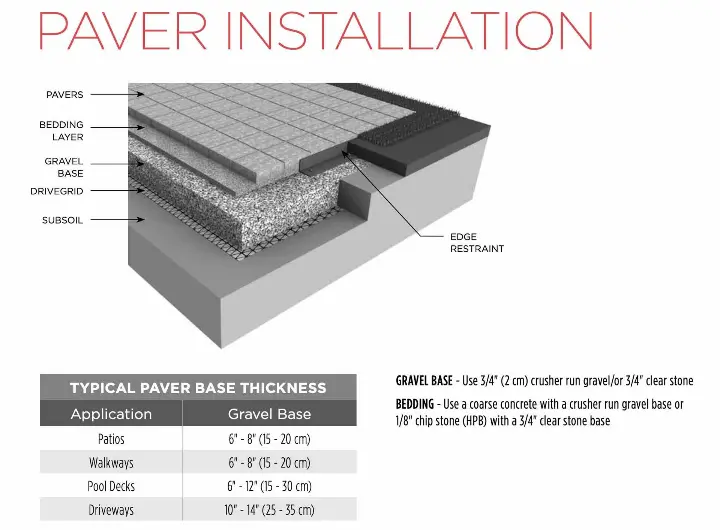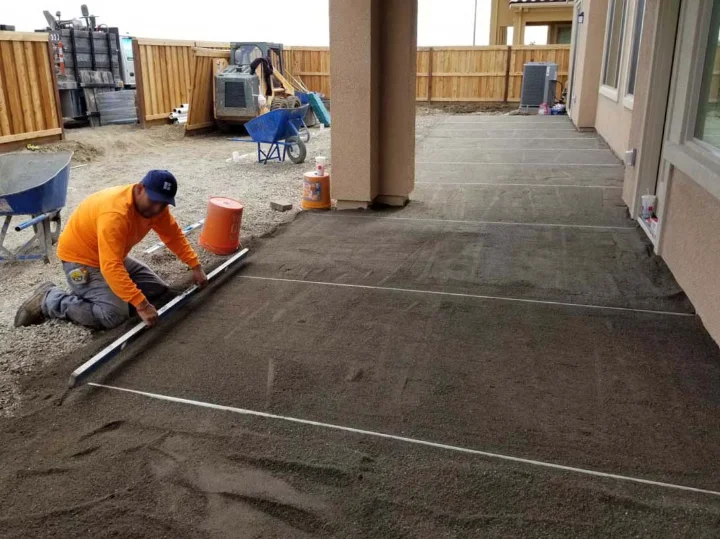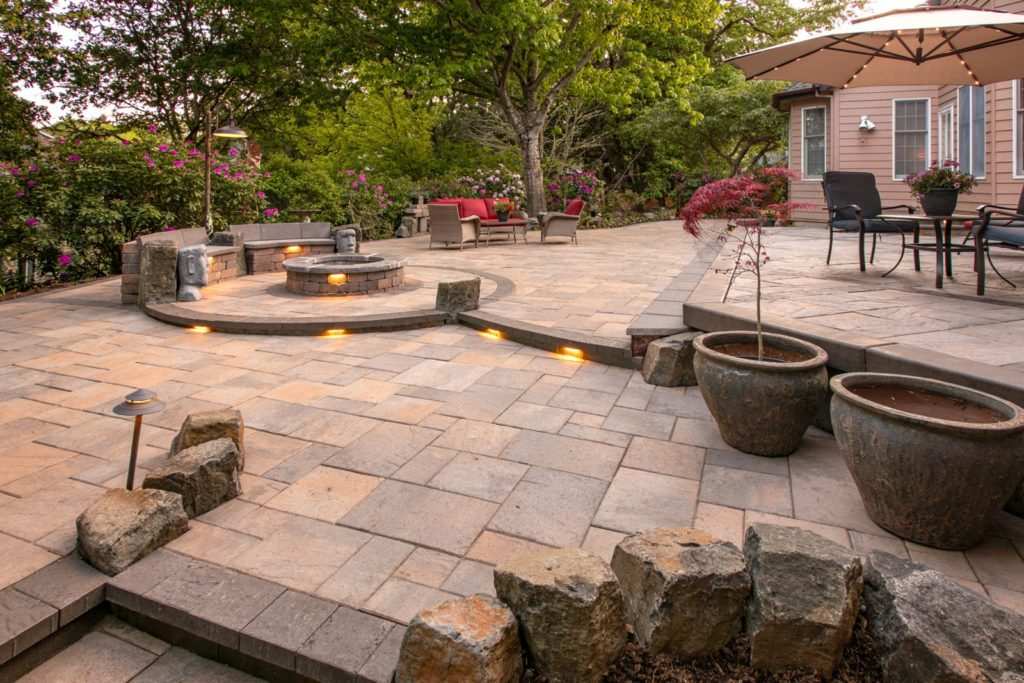Building a paver patio is one of the best investments for your home
Adding a patio to your property is always a smart investment, but building a paver patio is an even better one. Many homeowners dream of creating a beautiful, low-maintenance outdoor space, and at Mr. Mulch Landscape Supply we’re here to help turn that dream into reality. Read on to learn how to build a paver patio step by step, cool patio paver designs, plus find out the answer to typical DIY patio questions other customers have.
Why is a Paver Patio Right for You
Paver patios are easier to maintain than wood decks, more durable than poured concrete, and can last up to 50 years when installed correctly. Even better, a quality patio in Columbus, Ohio can offer a return on investment of up to 70%.
In this step-by-step patio installation guide, we'll walk you through how to build a paver patio in 10 easy steps.
how much does it cost to build a paver patio yourself
If you’re wondering how much it costs to build a paver patio, the good news is, it’s often far more affordable than hiring a contractor. One of the biggest benefits of a DIY project is controlling your own budget. This project isn't for the faint of heart though, but with our guide we break down the steps to make it as easy as possible for you to succeed.
Not only can you save on labor, but you'll also learn things like how many tons of gravel for paver patio base you actually need and how many pavers you need for your patio. While DIY vs professional patio installation cost will vary by project size and materials, doing it yourself is typically the cheaper route, especially if you already own or can borrow some of the tools.
If you’ve been asking, “Is it cheaper to build your own paver patio?” The answer is yes, and this guide will help walk you through every step of the process. Let's get started!

How to Build a Paver Patio
Step by step guide to install a patio.
1. What Tools Do I Need to Build a Paver Patio
(To install a patio we recommend these tools, but this project can be completed with different or less equipment then what is listed here)
- Tape Measure (to measure layout dimensions accurately)
- Landscape Spray Paint or Stakes and String (to mark the outline of the patio)
- Shovel or Excavator (for digging the base area)
- Wheelbarrow (to transport gravel, sand, or dirt)
- Rake (to level base material and sand bedding)
- Plate Compactor (Tamper) (to compact gravel base and pavers for stability)
- Hand Tamper (for compacting small or hard-to-reach areas)
- Level (to ensure the base, sand, and pavers are even)
- Straight 2x4 or Screed Board (to level the bedding sand using screed rails)
- Rubber Mallet (to gently tap pavers into place without damage)
- Masonry Saw or Paver Splitter (to cut pavers to fit edges and curves)
- Gloves (to protect hands from rough edges and tools)
- Broom (to sweep polymeric sand into the joints after installation)
- Garden Hose or Sprayer (to mist and activate polymeric sand)
2. How to Prepare the Ground for a Paver Patio
- Mark the area of the patio, walkway, or driveway. Draw out the perimeter of your patio area and mark the corners with stakes and attach string or spray paint around the perimeter.
- Call your utility companies to ensure that no cables are buried under this area of your property.
- After confirming no buried cables are under your future patio, excavate the area to the appropriate depth based on your project need.
- Compact the soil after excavating with a hand tamper to create a firm sub-base.
- Bonus Tip: Lay weed fabric over the soil to prevent weeds from growing up through your patio.
3. What Base do I need for a Paver Patio?
Here we'll answer the following questions many customers have: 'How deep should I dig for a paver patio base?', 'How much gravel do I need for a paver patio?', and 'how to compact gravel for paver base?'
- First, figure out how deep you want your base, we recommend digging 7-9 inches for an adequate base (4-6" for base gravel, 1" for bedding sand, and allow a couple inches for the paver thickness).
- There are a few gravel options you can use to make the base, but we've found that the best base material for a paver patio in central Ohio is a combination of #57 limestone gravel and #9 limestone gravel.
- From the heavy rainfall that Ohio receives, 57 limestone gravel and 9 limestone allow adequate drainage.
- This gravel combo also benefits the freeze and thaw climate in Ohio.
- Start by laying 4-5 inches of #57 limestone and another 1 inch of #9 limestone. Make sure to compact each layer before applying the next.
- To compact your gravel use a plate compactor (vibrating tamper), going over the area in overlapping passes.
- To figure out how much gravel you need, visit any of our gravel product pages for an easy to use gravel calculator.
- Bonus Tip: We offer patio base gravel delivery in Columbus Ohio!

4. How to Level Sand for Patio Pavers
- Layout 1 inch of mason sand overtop of the gravel base. This will be the bedding layer for your pavers to lay on. On our mason sand product page we also offer a construction sand calculator or call our store with your dimensions.
- Lay down the screed guides parallel on the sand (1" PVC pipes work well for this).
- Screed guides are a straight, narrow object placed on top of the base layer to level the sand correctly before you install pavers.
- Drag a straight board across the guides to screed the sand level.
- Fill in the low spots that you find from leveling.
- Remove the screed guides carefully and fill in any gaps they leave, then smooth them out.
- Bonus Tip: Immediately begin laying pavers before the level surface is interrupted.

5. Best Pavers to use for a DIY Patio
At Mr. Mulch, we offer quality Unilock pavers for sale in Columbus, Ohio. Unilock is a trusted hardscape manufacturer with over 50 years of experience. Known for innovation and durability, Unilock provides high-quality pavers and hardscape materials not only in Ohio, but across North America.
- A professional looking paver we offer is Beacon Hill Flagstone. Variations of Beacon Hill Flagstone (smooth vs regular) are our most popular paver to install for patios.
- We recommend pairing Beacon Hill Flagstone pavers with Copthorne or Hollandstone brick pavers around the patio’s perimeter to create a complementary accent border.
- For a clean and sharp looking brick paver, we recommend Holland Premier, or for a rugged and tumbled version we offer Hollandstone.
- An economical and easy to lay paver we recommend is Camelot square and Camelot rectangle patio paver. For an interesting patio laying pattern, try switching between square and rectangle pavers (shown in the picture above).
Looking for where to buy pavers in Columbus Ohio? These aren't all the types of pavers we offer, browse all our different types of pavers for sale online or in store at Mr. Mulch Landscape Supply.

6. How to Lay Pavers for a Backyard Patio
- Make sure to have paver edging around the border to help keep your pavers secure. Paver Patio edging materials we recommend using are:
- Depending on the paver, there are a few different variations of patterns you can lay. Unilock has a great paver laying guide by each paver type showing the design pattern and laying techniques.
- Once you decide on a pattern, begin installing the pavers.
- The pavers should have ridges on the side that indicate how close together they need to be.
- Try out different accents in your patio by using contrasting colors, types of pavers, or using interchanging laying patterns.
- Use string lines to keep the joint lines straight.
- Bonus Tip: Only walk on the laid pavers, refrain from stepping on your sand bedding before you lay the paver on top.
7. How to Cut Concrete Pavers
- To fit pavers around corners, bends, edges, or other objects in your patio use a Masonry-saw to cut the paver to shape.
- Always ensure proper safety whenever using a masonry saw to cut pavers. Safety guides can be found with the masonry saw.

8. How to use Polymeric Sand for Pavers
- Choosing the right joint material is important to secure the space in between your pavers and keep dirt/debris out. The best sand for patio paver joints we recommend is Polybind G2 Polymeric Sand for pavers in Columbus, Ohio.
- Choosing the right color paver sand makes a big difference in how your patio looks.
- Make sure your pavers are dry, then sweep the sand into the joints of your patio with a broom.
- Sweep off the excess sand covering your pavers (not the sand in the joints).
- Lightly mist the patio with water and let it dry (avoid rain and foot traffic for 1-2 days)
- Bonus Tip: Make sure there is no rain in the forecast because too much water can wash away the sand before it can set.
9. How to Seal your Patio
When choosing between patio sealer for pavers you can choose either a wet look or a natural/matte finish patio sealer. We recommend Surebond Sealer for either look you are interested in.
- Consider adding a protective sealer to prevent mold and daily wear and tear on your new patio.
- Wash your patio before applying the sealer because it will seal things like dirt and debris onto your patio.
- Apply the sealer evenly with a sprayer or roller.
- Let the sealer dry for 24 hours before walking on it.

10. How to Maintain a Paver Patio after Installation
Power washing your patio at the start of spring helps keep your patio looking new so you can enjoy it in the seasons that count. Another benefit to a paver patio is replacing broken pieces without having to redo the entire patio. Yearly touch ups are a great low-effort way to maintain your patio's elegance.

Ready to Build your Own Paver Patio?
Tackling a DIY paver patio can be a satisfying and affordable way to upgrade your outdoor space, so look to Mr. Mulch for your paver patio materials in Columbus, Ohio. For 30 years Mr. Mulch has been a trusted patio paver, sand, and gravel supplier in Ohio and we're happy to assist you with your landscaping or hardscape projects year round.
After reading this guide, you should feel more confident about the process of building your own paver patio. Here are some final questions and answers we often find customers have. These are common questions that come up when deciding between DIY vs professional paver patio installation.
Q. How long does it take to install a paver patio?
A. The time it takes to install a paver patio depends on your experience, size, complexity, and weather, but here’s a general breakdown:
- Small patio (100–200 sq ft): 1–3 days
- Medium patio (200–400 sq ft): 3–5 days
- Large patio (400+ sq ft): 5–7+ days
Q. Can I build a paver patio without concrete?
A. Yes, you can absolutely build a paver patio without concrete, and in most residential cases, it's actually preferred.
- Pavers are designed to be installed on a compacted gravel and sand base, not on poured concrete.
- A flexible base allows for drainage and movement, which helps prevent cracking and shifting over time.
- Concrete bases can trap moisture and may cause pavers to loosen or lift in freeze-thaw cycles.
Where to buy patio supplies in Central Ohio
If you're trying to figure out where to buy pavers in Columbus Ohio or the best paver styles for DIY patio we’ve got you covered. We carry premium patio supplies like Unilock pavers, gravel base, joint sand, paver edging, and patio sealer for pavers, all available for pickup or bulk delivery in Central Ohio.
At Mr. Mulch, we want you to succeed with your outdoor projects, if you're unsure where to start or how to calculate paver base material, our team is happy to help. Visit us in-store or contact us online to get expert advice and the landscape supplies you need to build a patio that lasts.


